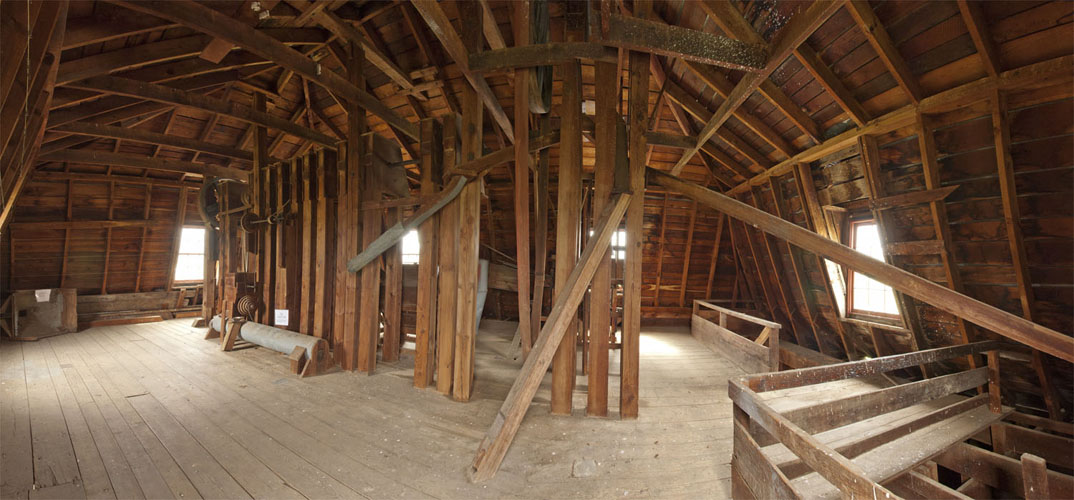Big Otter Mill is situated on the bank of the Big Otter River, a few miles north of the City of Bedford, Virginia on Route 122 North, south of Big Island.
The site of this mill has been used for grist and sawmills for more than two hundred years.
This mill was first built and operated by Joseph Hardy, Sr., a veteran of the Revolutionary War who settled here in the late 1700s. In 1785 the county granted him permission to erect a mill at this site which became operational in the 18th century. The Hardy Mill was sometimes referred to as Greenville Mill. And that building was washed away by flood in the 19th century. The replacement mill was believed to have been erected by William A. Hardy. Following his death in the late 19th century, the Hardy property passed through the hands of several different short term owners.
Mr. Reed Forbes and his family came from Franklin County, Virginia in the late 1800s to operate a mill at Kelso. Records show that in 1901 Forbes had purchased and began occupying a tract of land which encompassed the miller’s house adjoining the mill. He apparently placed the mill back into regular operation during that time. By 1910 he was able to secure a full title to the mill tract and the mill from its owners, W.I. and P.J. Langford, and the mill then became known as Forbes Mill.

Local tradition holds that a fire destroyed this mill building around 1916...
Forbes and his wife, Martha Jane Howell Forbes had nine children. Along with their father, several of the sons became wheelwrights, master builders and carpenters.
Before the 1917 a flood washed away the dwelling house and mill. Forbes and his sons first reconstructed the new house at a higher elevation above the river and replaced the mill in 1920. The new building, designed by Reed Forbes, was a combination of corn and flour mill. The mansard roof gave the mill three floors of working space. Four modern rollers were added to produce bleached flour in addition to conventional millstones for more coarsely ground products. The same year Reed’s son, 29 year old Robert Kelso Forbes was documented as the miller. In 1928 Reed Forbes died. Robert inherited the mill and real estate and operated the mill until 1936.
The mill with the adjoining miller’s house was sold to Charles David Atkinson who never came to live in the area but hired millers to carry on the business. It was during these years that the name Big Otter Mill was first used. The mill produced its brand names of Golden Eagle Flour and Pioneer Corn Meal. They also undertook commercial grinding.
By 1946 Atkinson sold Big Otter Mill and the home to Mr. Julius O. Kirby, ...
who continued to run the gristmill, although somewhat irregularly. According to Kirby’s son the mill ceased commercial operation about 1950. To settle the Kirby estate after the death of Mrs. Kirby about 1996, David Cole, a semi retired contractor, builder, and preservationist, purchased the mill and took steps to stabilize, repair and restore the mill building and bring its equipment back to working condition. After Cole moved away, it was necessary for him to dispose of the building and he donated the property as a historical landmark to Bedford County. The county along with interested citizens has formed the Big Otter Mill Foundation which is in the process of determining the steps needed to restore the mill to working order.
Like many rural mills, this mill served as a community center of sorts...
In addition to flour and meal grinding, a saw mill and store on the property brought neighbors together to work, socialize and shop. The store, run by members of the Hardy family in the 20th century, served a political function as the polling place for the local precinct. Paul Forbes, Reed’s grandson recalled that during a busy season this mill would operate 24 hours a day. Another person recalled the mill pond being a popular place for Sunday boat rides.
Family members related a story about a child playing across the road along the water brought in the race from the dam upstream on Big Otter. The water in the race ran rapidly and was diverted under the roadway into an open wooden raceway leading to the water wheel that powered the mill. One of the children had slipped into the stream of water and was pulled into the flow under the road Screams of panic drew attention and a person at the raceway was able to snatch the child to safety before she went into the turning millwheel.
